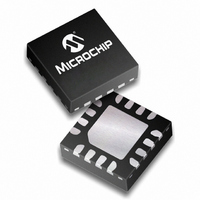MCP73853-I/ML Microchip Technology, MCP73853-I/ML Datasheet - Page 17

MCP73853-I/ML
Manufacturer Part Number
MCP73853-I/ML
Description
IC,Battery Management,LLCC,16PIN,PLASTIC
Manufacturer
Microchip Technology
Datasheet
1.MCP73853T-IML.pdf
(24 pages)
Specifications of MCP73853-I/ML
Function
Charge Management
Battery Type
Lithium-Ion (Li-Ion), Lithium-Polymer (Li-Pol)
Voltage - Supply
4.5 V ~ 5.5 V
Operating Temperature
-40°C ~ 85°C
Mounting Type
Surface Mount
Package / Case
16-QFN
Output Voltage
4.221 V
Output Current
100 mA
Operating Supply Voltage
4.5 V to 5.5 V
Supply Current
4 mA
Maximum Operating Temperature
+ 85 C
Minimum Operating Temperature
- 40 C
Mounting Style
SMD/SMT
Uvlo Start Threshold
4.65 V
Uvlo Stop Threshold
4.55 V
Lead Free Status / RoHS Status
Lead free / RoHS Compliant
Lead Free Status / RoHS Status
Lead free / RoHS Compliant, Lead free / RoHS Compliant
Available stocks
Company
Part Number
Manufacturer
Quantity
Price
Company:
Part Number:
MCP73853-I/ML
Manufacturer:
AVAGO
Quantity:
101
Company:
Part Number:
MCP73853-I/ML
Manufacturer:
Microchip Technology
Quantity:
135
Part Number:
MCP73853-I/ML
Manufacturer:
MICROCHIP/微芯
Quantity:
20 000
6.1
Due to the low efficiency of linear charging, the most
important factors are thermal design and cost. These
are a direct function of the input voltage, output current
and thermal impedance between the battery charger
and the ambient cooling air. The worst-case situation
exists when the device has transitioned from the
Preconditioning mode to the Constant-current mode. In
this situation, the battery charger has to dissipate the
maximum power. A trade-off must be made between
the charge current, cost and thermal requirements of
the charger.
6.1.1
Selection of the external components in Figure 6-1 is
crucial to the integrity and reliability of the charging sys-
tem. The following discussion is intended to be a guide
for the component selection process.
6.1.1.1
The preferred fast charge current for Lithium-Ion cells
is at the 1C rate, with an absolute maximum current at
the 2C rate. For example, a 500 mAH battery pack has
a preferred fast charge current of 500 mA. Charging at
this rate provides the shortest charge cycle times
without degradation to the battery pack performance or
life.
400 mA is the typical maximum charge current
obtainable from the MCP7385X devices. For this situa-
tion, the PROG input should be connected directly to
V
6.1.1.2
The worst-case power dissipation in the battery
charger occurs when the input voltage is at the
maximum and the device has transitioned from the
Preconditioning mode to the Constant-current mode. In
this case, the power dissipation is:
Where V
(I
V
Power dissipation with a 5V, +/-10% input voltage
source is:
With the battery charger mounted on a 1 in
1 oz. copper, the junction temperature rise is approxi-
mately 50°C. This would allow for a maximum operat-
ing ambient temperature of 35°C before thermal
regulation is entered.
2004 Microchip Technology Inc.
SS
REGMAX
PTHMIN
PowerDissipation
PowerDissipation
.
Application Circuit Design
) is the maximum fast charge current, and
is the minimum transition threshold voltage.
DDMAX
CURRENT PROGRAMMING RESISTOR
(R
THERMAL CONSIDERATIONS
COMPONENT SELECTION
PROG
=
is the maximum input voltage
)
=
V DDMAX V PTHMIN
5.5V 2.7V
–
–
475mA
I REGMAX
=
1.33W
2
pad of
6.1.1.3
The MCP7385X devices are stable with or without a
battery load. In order to maintain good AC stability in
the Constant-voltage mode, a minimum capacitance of
4.7 µF is recommended to bypass the V
This capacitance provides compensation when there is
no battery load. In addition, the battery and intercon-
nections appear inductive at high frequencies. These
elements are in the control feedback loop during
Constant-voltage
capacitance may be necessary to compensate for the
inductive nature of the battery pack.
Virtually any good quality output filter capacitor can be
used, independent of the capacitor’s minimum
Effective Series Resistance (ESR) value. The actual
value of the capacitor (and its associated ESR)
depends on the output load current. A 4.7 µF ceramic,
tantalum or aluminum electrolytic capacitor at the
output is usually sufficient to ensure stability for up to
the maximum output current.
6.1.1.4
The MCP7385X devices provide protection from a
faulted or shorted input or from a reversed-polarity
input source. Without the protection, a faulted or
shorted input would discharge the battery pack through
the body diode of the internal pass transistor.
6.1.1.5
In the stand-alone configuration, the enable pin is gen-
erally tied to the input voltage. The MCP7385X devices
automatically enter a low power mode when voltage on
the V
reducing the battery drain current to 0.28 µA, typically.
6.1.1.6
Two status outputs provide information on the state of
charge. The current-limited, open-drain outputs can be
used to illuminate external LEDs. Refer to Table 5-1
and Table 5-2 for a summary of the state of the status
output during a charge cycle.
6.2
For optimum voltage regulation, place the battery pack
as close as possible to the device’s V
It is recommended that the designer minimize voltage
drops along the high-current-carrying PCB traces.
If the PCB layout is used as a heatsink, adding many
vias in the heatsink pad can help conduct more heat to
the backplane of the PCB, thus reducing the maximum
junction temperature.
DD
input falls below the UVLO voltage (V
PCB Layout Issues
EXTERNAL CAPACITORS
REVERSE BLOCKING PROTECTION
ENABLE INTERFACE
CHARGE STATUS INTERFACE
MCP73853/55
mode.
Therefore,
DS21915A-page 17
BAT
BAT
and V
the
pin to V
SS
bypass
STOP
pins.
SS
),
.













